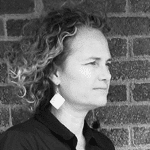Architecture for Humanity’s initial mission was to find five schools to repair or rebuild, then work with the school director and community to design the campus, building, or addition and oversee construction. Two of the original five schools have been completed, and two others are under construction.
My philosophy is to design buildings intelligently green, without a lot of bells and whistles, then work in a few innovative strategies here and there. Sustainable strategies for the schools were simple but ‘dark green,’ so to speak. The buildings were simple and utilitarian, but we designed them to let in natural light and be thermally comfortable without HVAC systems or even ceiling fans.
We worked hard to incorporate a cultural connection, engaging local artisans to create railings, shutters, and doors using local materials: bamboo, palm leaves, even oil drums. In a disaster context, art seems frivolous when schools are struggling to keep classes going, but the Haitian culture is busting with art. We designed functional art into the schools.
We selected local contractors and competitively bid projects in a trial-and-error process. First, we created a sample project and invited contractors to put together a bid showing a detailed breakdown of materials and labor. The prices came in wildly high and low, so we switched to providing the quantity take-offs and let the contractors fill in unit prices for materials and labor.
As architects from the United States and other developed nations, we’re used to a process that works. In Haiti, we had to adjust our approach to address factors like cultural dynamics and complex land-tenure situations, gangs, bribes, cholera, hurricanes, rock throwing, and roosters crowing at all hours of the day and night. We also encountered difficulties in finding workers who could read plans and accurately execute work in the field. From the start, we partnered with Build Change to conduct on-site construction training that covered the basics of mixing mortar, building concrete block walls, bending and tying rebar, and pouring concrete. At first we were visiting the construction sites every week or two but found whole foundations and walls and beams had to be torn out and rebuilt to plan, so we hired and trained Haitian staff to be on-site daily helping and directing the workers.
The need for repaired and replacement buildings was and still is so great in Haiti. We began branching out into planning new communities, repairing medical clinics, and partnering with other nongovernmental organizations like Habitat for Humanity, Grameen Bank, and JPHRO, the organization with which Sean Penn is affiliated.
My main regret is not working faster. In the midst of a daily routine, you tend to lose a sense of urgency, and the year I was there flew by. There is so much more to do. Despite all of the challenges, the rewards of this experience were tremendous. I found inspiration in the smiling faces of schoolchildren when they were in their new space or at a building dedication. I also appreciated the opportunity to delve into the Haitian culture.
I learned lessons in Haiti that I’ve incorporated into my practice at home, as well. I tend to feel creating a building is a complicated process, but architecture doesn’t have to be complex. It just needs to work well and be beautiful to enhance our lives.
Stacey McMahan, AIA, LEED AP, is a Midwestern native. She graduated from Kansas State University’s architecture program and is now is a principal at Koch Hazard Architects. In 2010, she was chosen by the AIA and the USGBC as Architecture for Humanity’s Sustainable Design Fellow and led design efforts in Haiti after the 7.0 magnitude earthquake of January 12, 2010. She lives in Sioux Falls, SD, with her family.


